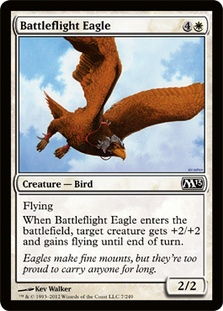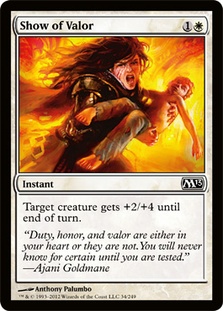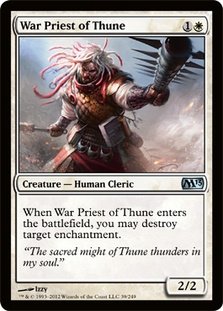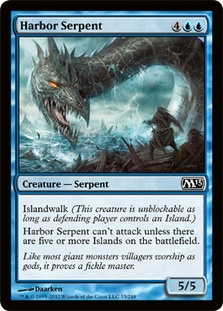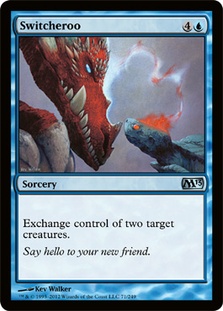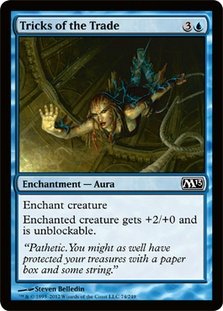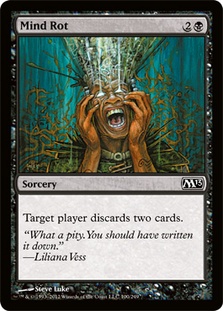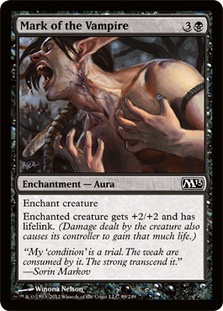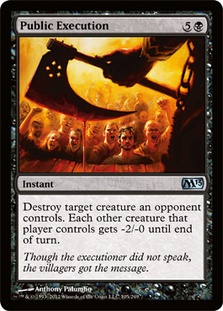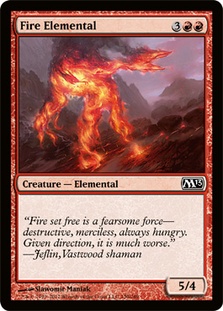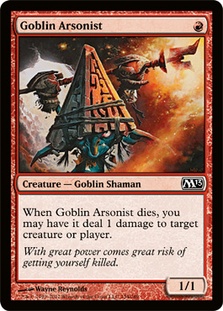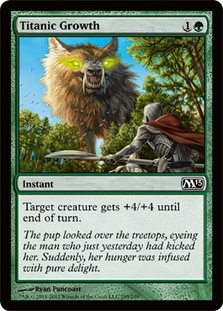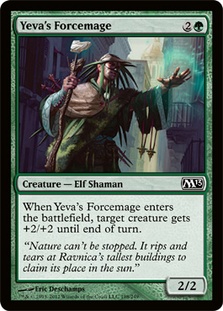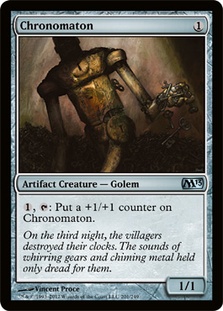It has been just under a month since I first played Magic 2013 Limited, and I still think the format is as awesome as when I started. It may have even gotten more awesome since then. Since the first day of the format I felt it was very skill intensive, and I’ve only learned more since then to make me believe so. Given the recent release of the set on Magic Online, I feel it deserves an updated look.
Rather than go back and revise my entire first pass at the format, I’ve decided to share some of the more subtle and surprising aspects of cards I’ve discovered so far. I’ve tried to focus on in-game scenarios because of how much this format boils down to play decisions, but there are also a couple Draft-based notes I’ve made. Again, I am almost completely ignoring the rares. I haven’t played a lot with most of them, you likely won’t play against most of them that often, and in my experience the powerful ones are fairly straightforward.
Battleflight Eagle
There are six common or uncommon creatures in Magic 2013 with over two toughness and the ability to block fliers. Add in a single exalted trigger and Serra Angel, Fog Bank, and Sentinel Spider are the only non-rares that can block Battleflight Eagle without being a chump block or trade. To put this in context, that’s only about one-third of the common and uncommon fliers.
The 2/2 flying body is worth much more than it was when this card was Welkin Guide. That was a world of Sanctum Gargoyles, Court Archers, and Waveskimmer Avens where your 2/2 body was worse than over half the non-rare fliers. Back then you would often slow roll the trigger to kill your opponent with a Rakeclaw Gargantuan. In this set, most of the time you should just be cashing in on the trigger as super-haste and continuing the beats with the Wind Drake body.
Show of Valor
Your opponent makes a play expecting your guy to die and their card to work. You play a pump spell. Your guy now doesn’t die and their spell fails or their guy dies. If you aren’t having your pump spells work this way, you likely aren’t getting full value out of them or have reached the end game scenario where you just turn them into Lava Spikes.
If you break things down, there are two halves of this equation: saving your guy and killing theirs.
The past few Limited formats have mostly been about saving your guy. You attack with your guy, they block, and your pump spell is just like Phantasmal Image on the guy that normally would have traded. This was especially obvious in Innistrad, where everything was around 2/2 size and cards like Moment of Heroism were often just another Grizzly Bears. Sometimes you upgraded a bit and your "replacement" 2/2 took out a 2/3, but you were casting that spell regardless of how they blocked as long as it meant you ended up with more guys in play next turn.
The defining characteristic of these formats was the creature size scaled poorly with mana cost. For example, compare Villagers of Estwald or Darkthicket Wolf to Night Revelers. The two or three mana creatures were perfectly capable of brawling through the high drops without any assistance.
I mentioned this last week, but Magic 2013 has a properly scaling curve. You have the full progression of Grizzly Bears, Grey Ogre, Hill Giant, Durkwood Boars holding constant through the format: Timberpack Wolf, Yeva’s Forcemage, Primal Huntbeast, Sentinel Spider. The other colors hold true to this as well, missing a drop where they should be weak and adding abilities as necessary. In general, this means using your pump spell when they block 2/2 on 2/2 is a waste, as your Silvercoat Lion isn’t going to get much better than trading for theirs.
So save your Show of Valors for when they kill something that matters or save something that does. Make your once exalted Battlefield Griffin stick around through a Faerie Invaders or take down a Sentinel Spider. Don’t just kill a Canyon Minotaur if your hand is full of midrange guys already.
War Priest of Thune
White has Pacifism, Angelic Benediction, and Oblivion Ring. Blue has Encrust and Tricks of the Trade. Black has Crippling Blight and Mark of the Vampire. Grizzly Bears on turn 2 has also not been this bad for a long time.
Unless your opponent is G/R, odds are you should hold this guy in your hand until you get value or need him in play. He is partly a Karmic Guide, partly a Flametongue Kavu. If you need the body early to stabilize you can obviously cast him, but fortunately the color combo you would most likely want to do that against is green-red!
Harbor Serpent
This guy is as good as a bomb rare in blue mirrors. Even outside of those the 5/5 body is much bigger than it ever has been before. I would not be afraid to maindeck this card on a regular basis. See Fire Elemental below.
Switcheroo
It’s worth noting that the value of Switcheroo can vary drastically between decks and matchups, unlike Mind Control that ranged from just really good to unbeatable. If all of their guys are basically the same, like in true black-white exalted decks or certain blue mirrors, the card doesn’t generate a lot of value. If all your guys are good, like in a lot of blue-black control decks, you won’t have anything worth upgrading.
If you draft Switcheroo early, as you should, be aware of this fact and consider that you might want more random bodies in your deck to make a Mind Control with. Augur of Bolas, Elvish Visionary, Rummaging Goblin, and similar cards all get a real boost when they can turn into 4/4s.
Also be aware you should play this card very carefully against the color blue. Unsummon was always one of the better answers to Mind Control, and getting your Switcheroo Unsummoned feels absolutely terrible. This card is also very good against white as you can exchange a Pacified creature and trade nothing for something.
Tricks of the Trade
Sometimes your pile of good blue cards is lacking in ways to beat certain things and you just have to race. Alternatively, sometimes you just need a real way to kill someone when they have a few "irrelevant" creatures in play. Tricks of the Trade does both extremely well.
It combos well with green and red guys just based on their size. It combos well with white and black creatures based on exalted (and is especially good on Liliana’s Shade). It even combos well with blue guys, turning the two semi-defensive three-drops (Scroll Thief and Watercourser) into serious threats.
Play this card more and pass it less.
Duress
Duress costs one mana, but it isn’t really a one-drop most of the time. You can cast it then, but you are often giving up good value to do so.
Times to play Duress:
- Right before you play the card that should end the game. Pluck their answer to your Krenko, Mob Boss, then win easily by activating it more than zero times.
- Slot it into your curve in the midgame. Compared to a turn 1 Duress you get a Psychotic Haze style effect where you get to choose from what was the top of their library. You can also catch people in scenarios where they expend an "extra" piece of removal early and Duress catches the spell they were leaning on to answer a threat later, also known as how Duress can take two cards. Just be aware that Mark of the Vampire and Tricks of the Trade exist, and if you were planning on Duressing those you should time it accordingly. The same applies to Rancor, but there’s only so much you can reasonably do there unless you know they have it in their deck.
- In the late game when you draw it to their no cards in hand, wait until right before you make an action that their trick would make sense against. Duress them before your relevant attack to take a Divine Verdict or pump spell, or Duress them before you play something relevant to take their counter or removal spell. Don’t just run it out as soon as they have a card left in hand. People can and do hold lands for this exact reason.
Mind Rot
Duress may be a turn 1 card from time to time. Mind Rot is almost never a turn 3 card. This kind of behavior is what makes people dislike the card in the first place.
Times to play Mind Rot:
- Almost never if they have five or more cards in their hand. Odds are some of them are bad enough that they are happy to discard them.
- Usually when they have exactly two cards in hand. This should be very obvious.
- Most of the time when they go to one card in hand without having been hellbent before. Things don’t usually get much better for the card once they go hellbent for the first time as the odds of them holding a spell they draw are low. If it has passed that point, see point 3 on "Times to play Duress."
- After your opponent misses a land drop midgame with cards in hand. Odds are all they have are spells left, and hitting the ones they haven’t cast yet is probably good.
- Against decks with high-end curves, any time they drop to four or less cards with four or less lands in play. Make them decide whether to keep lands or spells. If you wait, you are less likely to disrupt their flow up the curve.
Mark of the Vampire
Times to play Mark of the Vampire:
- Early when you have other threats. If they have it, they have it and they then have to answer a Liliana’s Shade. If they don’t, they die.
- Rarely when you are ahead unless it ramps up the clock. No need to get more ahead when you have a card that can swing things back in your favor both with lifelink and by just making a monster.
Public Execution
This format often ends up being fairly top end dependent. Usually by the time you are casting six-drops, there aren’t enough guys floating around combat to make the -2/-0 extremely relevant. I would still be very happy with a six-mana Murder, and the upside is a huge blow out when it comes up. Not worse than I thought it would be, but the -2/-0 is. Play it accordingly and don’t get greedy. Be happy just killing what you should be killing.
If they kill their own guy in response, you lose the mini-Safe Passage effect. Be aware this can happen.
Fire Elemental
Spined Wurm was a huge beast back when it was the core set fatty of choice. I completely failed to make the connection earlier and almost immediately dismissed Fire Elemental when the set first was spoiled. Turns out it is probably the second best red creature behind Mogg Flunkies. Oops.
Moving past that, Fire Elemental opens up an archetype that in the past has constantly struggled: black-red kill everything. Mixing red and any of the non-green colors can accomplish this, but black-red historically has been the normal pairing for this deck and generally gives the best idea of what’s going on.
The issue in the past has always been that you would run out of one for ones without doing anything and die. Not only do black and red have card drawing and filtering in this set to offset this, but they have Fire Elemental.
First off, Fire Elemental represents a real clock on an open board. If you just land it and clear the path, you can easily race a single opposing creature. The 5/4 body is also huge. Just by landing it, you gain virtual card advantage with which to leverage your removal. Killing a Canyon Minotaur with a Murder should no longer be necessary. Just slam a 5/4 and go to town. If they double block it down, just play another one. It’s a common; you should be able to easily find more.
In the past you would be stuck piecing together a victory with the tiny incidental bodies red and black were used to. Fire Elemental gives a Dinosaur to the archetype that needed it the most.
Goblin Arsonist
Mogg Flunkies needs help to get going. This isn’t in the normal aggro needs a full curve to work sense—it actually says to right on the card. While Mogg Flunkies into a three-drop is a nice curve, it still means your first Flunkies swing is on turn 4 when it can be matched in combat by a bunch of options if you are on the draw. Rather than have a deck that leans heavily on the coin flip, building to attack on turn 3 with Flunkies will mean your opponent should have little to no ability to block well that first turn and be down three or more life to start.
Goblin Arsonist is the perfect body for the role. It isn’t an aggressive all-star on its own, but by activating your Flunkies on turn 3 it becomes one. It also trades up the curve when blocked by most three-drops, meaning you either gain tempo when they trade or your Flunkies has a buddy hanging around for later. The Arms Dealer synergy is just icing on the cake, though the +1 damage is much less relevant than it just being a Goblin to get Fodder Cannoned away.
Mindclaw Shaman
For those of you who remember playing with Bloodbraid Elf in Jund, think about how you played the card in the mirror. You almost never cast the card when they didn’t have a target for a removal spell you might cascade into because it was just a 3/2 haste then.
Mindclaw Shaman is the same way. Limited is just a Jund mirror with much worse cards. Unless you can take their removal spell for the two for one when you cast it, I would slow roll it for value unless you just want a Duress.
Rummaging Goblin
I hate this card and am actively sad to play it. Considering I played upwards of three Merfolk Looters in some Draft decks, I find this shocking. Considering how often I find myself trying to find a burn spell for the win in Limited, I was stunned.
The 1/1 body means much less in red than it did in blue. Zac Hill mentioned last Friday that Merfolk of the Pearl Trident was reprinted when they realized blue decks wanted the 1/1 body in some matchups, and Merfolk Looter was just that. Even if it was just a chump blocker in some combat, that was worth a decent fraction of a card as you would gain value back from the rest of your blocks or lack thereof. Red is not that way. The 1/1 doesn’t help your team push through. Playing this guy on turn 3 is not aggressive.
Even if you are cool with the 1/1 body, you have to accept that you are investing an actual card into it. Blue was fine with this as its other card draw let it keep a reasonable hand size through the game. Red doesn’t have access to Divination. It has what it gets. Looting is much worse when you have fewer cards to choose from when making your discard. I also assume the discard then draw sequencing compounds this issue.
Finally, there’s the overlap with Wild Guess. If I cast a Wild Guess, I effectively get to Loot twice. If I play Rummaging Goblin, I have to wait three more turns before I exceed that amount. It’s a lot harder to push for the Goblin when another card at the same rarity does the job as well or better.
I’m not saying I don’t play Rummaging Goblin, but he is usually the 23rd card in any deck I build.
Also worth noting again: Lootings don’t mix with seven-drops. It’s hard to discard something you don’t want in your hand if you want land and spells.
Titanic Growth
See my giant section on Show of Valor and then some. Titanic Growth pushes you four mana up the curve, allowing your random two-drops to trade for six-drops instead of "just" fives.
Yeva’s Forcemage
Combine the discussion of how 2/2 bodies aren’t that relevant from Show of Valor with the discussion of Battlefield Eagle. Yeva’s Forcemage should usually be saved until it pushes through another creature. If you cast it on turn 3, it will gain you two damage now, but if it means your 2/2 becomes a 4/4 attacks into their 3/3, it gained you four damage. That isn’t counting a Prey Upon setup or any additional damage that could be gained from a larger target. If your opponent isn’t well set up to blank a 2/2 it’s probably fine, but in that case their hand or deck seems subpar.
Chronomaton
My opinion of this guy is constantly increasing. The previous statement was also not intended to be a riff on the card’s ability. Playing him on turn 1 then activating on turn 2 is almost strictly better than the "default" play of turn 2 Grizzly Bears. He is on curve for both aggressive and defensive reasons and sticks around to become a huge Wall and end game threat.
Only two notes on rares:
All three Wrath effects are much better than in past sets. They are much easier to set up, and the cards or card quality you gain in the exchange matters a ton. Planar Cleansing, Mutilate, and Magmaquake are extremely high picks compared to their equivalents the past couple times around, which were just good and not insane.
Exalted is not optional. Intrepid Hero fights his own color very well on top of just generally being awesome.
To close, I would like to present the list of cards I still haven’t quite rated properly yet. Some of them are just due to not playing with them enough; others are due to mixed results. If you have any strong opinions on these cards, feel free to share them here or tweet them to me.
Faith’s Reward
Rain of Blades
Touch of the Eternal
Courtly Provocateur
Downpour
Hydrosurge
Disentomb
Cleaver Riot
Wall of Fire
Fungal Sprouting
Mwonvuli Beast Tracker
Akroma’s Memorial

